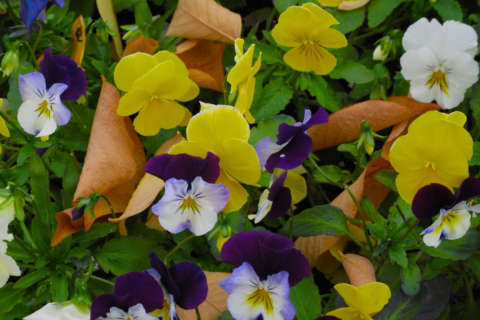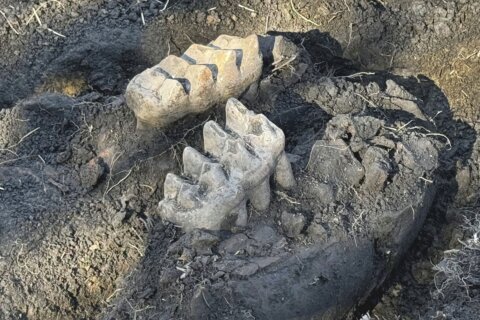I’ve always adored dahlias – in other people’s gardens. As much as their cheerful appearance intrigued me, there was something about the planting, staking, digging up and storing-over-winter routine that intimidated me.
But the longer I garden, the more I grow to appreciate their beauty and amenability.
For one, they’re available in so many different sizes, colors and even flower shapes that it’s fair to say no two dahlia cultivars are alike. And the choices! There are anemone, cactus, peony, orchid and waterlily types; singles, doubles and even dinner plate dahlias as large as, well, dinner plates.
With 42 recognized species and hundreds of hybrids, it’s impossible not to find at least one that will complement your garden.
Dahlias bloom in cut-and-come-again fashion, which is to say you can pick bouquets to fill as many vases as you can, and the plants will continue to produce flowers from summer straight through fall.
“Dahlias are actually simple to grow,” Lauren Sikorski, co-owner of Sow-Local, a small, specialty cut-flower farm in Oakdale, New York, told me, and she’s right: Caring for dahlias doesn’t require any advanced skills. They’re just a bit time-consuming and particular about their growing conditions.
The plants do not like heat or “wet feet”, ” gardening term that refers to soggy conditions around roots. And they “detest clay soil,” she said. If you’re working with heavy clay, incorporating a generous amount of compost into beds will improve drainage.
Typically grown in cooler regions and removed from the ground in fall because they will not survive winter outdoors, the plants are considered hardy from USDA zones 8-10.
To grow dahlias in those warmer regions, where the plants bloom from November through December or January, plant tubers in September or October. Cut plants down to the ground after they wither, apply mulch over the soil to keep it cool, and hope for another show from late winter through mid-spring. Then cut them down again, top dress with compost or mulch and leave them be until next year. In the hotter zones 9 and 10, dahlias perform best with some shade.
In the cooler zones 7 and lower, such as where Sow-Local is based, tubers should be harvested after the first hard frost. When the plant’s foliage has turned black and slimy, Sikorski advises, remove dead foliage and cut plants nearly to ground level. After the first couple of dry days, sometime during the next week or two, use a pitchfork to gingerly lift them out of the ground, taking care not to damage the tuber clump.
Gently shake soil off the tubers (they’re fragile), give them a quick rinse and set them out to dry for a few days. Brush off any remaining soil and, if you have different varieties, tag them because I guarantee you won’t remember which is which come spring.
“If you grow a large variety of sizes and colors of tubers, labeling is very important and can be tricky,” Sikorski says, adding that it’s much easier to label plants during the growing season, when you can see what you’re dealing with, than after the first frost.
Sikorski places tubers directly into cardboard boxes and stores them at 40-45 degrees in a dry place. Many growers, however, prefer to place them into gallon-size, perforated (for air circulation) produce bags with four cups of vermiculite, sphagnum peat moss, wood shavings or sawdust, then packing the bags into covered boxes and storing similarly.
Check stored tubers once a month over the winter and, if any are slightly shriveled, sprinkle lightly with water. Severely shriveled ones can be removed and soaked in water overnight in an attempt to rejuvenate them. If they plump up, pat them dry and return to storage; if they don’t, discard them, along with any that are moldy or rotted. Be prepared to lose about 10 percent of stored tubers.
In spring, after the danger of frost has passed, plant tubers in a spot that gets at least six hours of sunlight daily. For an earlier bloom, you can give them a head start by planting them indoors in pots about a month earlier, then transplanting into the garden after the last frost.
Insert 4-to-6-foot stakes (determined by the mature height of the variety you plant) into the soil about an inch away from tubers and secure stems as they grow. This will keep them from flopping over and protect from storm and wind damage.
If you’d like to grow dahlias next year, order tubers now. Most catalogs will ship them in spring, but Southern gardeners will have to store them over summer, as above, for fall planting.
—-
Jessica Damiano writes the award-winning Weekly Dirt Newsletter and regular gardening columns for The AP. Sign up here to get weekly gardening tips and advice delivered to your inbox.
—-
For more AP gardening stories, go to https://apnews.com/search?q=gardening#nt=navsearch
Copyright © 2024 The Associated Press. All rights reserved. This material may not be published, broadcast, written or redistributed.







